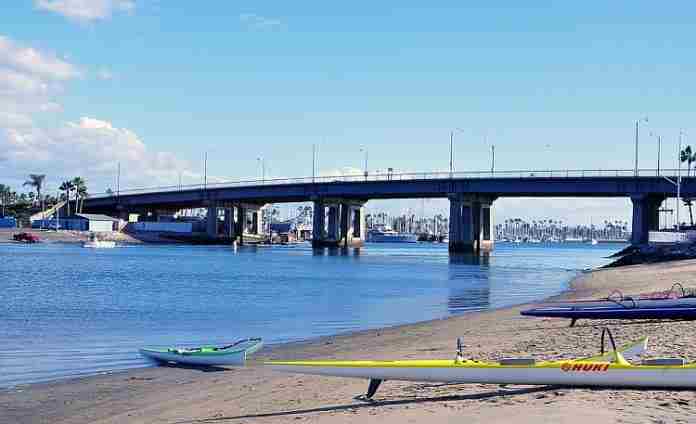The International Olympic Committee has trumpeted the benefits of its Agenda 2020 reform program, one of the first initiatives undertaken by then-new IOC President Thomas Bach in December 2014.
Its concepts significantly changed the bidding process for the Olympic Games and Winter Games, in part by emphasizing the use of “existing facilities and the use of temporary and demountable venues.”
That has had an important impact on the way bids for Games have been constructed, including the award of the 2028 Games to Los Angeles, where no new sports venues need to be built.
Or rebuilt. But will that change?
The international federation for rowing – the Federation Internationale des Societes d’Aviron (FISA) – reported that in its FISA Council meeting a couple of weeks ago in Lausanne (SUI):
“The Council was presented with a proposal to study an alternative venue for the LA2028 Olympic Games. The bid proposal was to stage this regatta at Lake Perris, a reservoir on the east of Los Angeles which would require a satellite Olympic Village.
“LA2028 proposed that an existing venue in Long Beach, California be considered. The Long Beach Marine Stadium was the Rowing venue for the 1932 Olympic Games and would allow the athletes to stay in the main Olympic Village at UCLA. The Council agreed to proceed with more detailed studies on the tide impacts on fairness and the possible reduction of the race distance.”
This is a fascinating turn of events, and one which is quite familiar to those who have followed the odyssey of Los Angeles’s bids for the Olympic Games since the revolutionary Games of the XXIIIrd Olympiad in 1984.
I was privileged to be the author of the Los Angeles bid for the 2012 Olympic Games and the technical director (and part author) of the bid for the 2016 Games. We lost both times in the domestic round, as the United States Olympic Committee picked New York and then Chicago, both of which lost at the international level.
Our venue for rowing and canoeing for both bids was, in fact, the Long Beach Marine Stadium. It had the benefit of being within the greater Los Angeles area and not as isolated as Lake Casitas – north of Los Angeles in Ventura County – was in 1984. Although adjacent to the Pacific Ocean, it was inside the Long Beach breakwater and tidal activity was within tolerable limits for morning competitions.
But there was a big problem: the J.H. Davies Bridge.
Built in 1955 (Long Beach structure no. 53C0209), it bisects the Marine Stadium, with two massive pillars in the water that create three lanes for rowing, but eliminates the clear span of the channel that was used in 1932.
It’s not a problem for recreational rowers, and canoeing and rowing training has continued unimpeded. But for an Olympic Games, requiring a 2,000 m course and 6-8 lanes, the Marine Stadium was impossible to use, as the available course length between the end of the stadium and the bridge was only 1,700 m.
Or was it? In the 2012 and 2016 contexts – with the U.S. bids created in 2001 and 2007, prior to Agenda 2020 – if we were going to use the Marine Stadium, we had to do something about the bridge.
An engineering study was undertaken to see what the possibilities and costs were to remove the pylons and re-create the 1932 rowing channel. The study came back with:
● The pylons could be removed and the bridge re-engineered, either as a Tied Arch Bridge (estimated at $22.6 million), a Cable-Stayed Bridge ($28.0 million) or a Segmental Concrete Bridge ($24.4 million). The work would take about 15 months.
● The result would be a clear, deep channel of 300-320 feet wide (91.5-97.5 m) with a total available length of about 2,400 m, fine for a full-size rowing course for the Games. The total width of the channel would be about 375 feet, but not all of it could be used for rowing because of the shallow depth at the sides.
● The length of the channel and space available on part of both shores (at that time) would allow for about 25,000 temporary seats for spectators and many more to be standing.
The cost of fixing the bridge would be paid entirely by the Los Angeles organizing committee. That was – in the pre-Agenda 2020 days – the cost of advancing the bid to avoid being rejected because of an insufficient venue for rowing.
For 2028, the Los Angeles bidders identified Lake Perris, a huge, artificial lake completed in 1973 and a favorite for recreation in Riverside County. The lake is 72 miles east of downtown Los Angeles in the Moreno Valley area and would require the use of a satellite Olympic Village to get the rowers to and from the facility in reasonable time.
Now the FISA will get into the same details we did years ago, with the same issues concerning the Davies Bridge across Second Street and the possible short course.
But the discussion, in light of Agenda 2020, will be fascinating (but mostly private). The LA28 folks will certainly not be excited about fronting $30 million or more to refit the bridge; the City of Long Beach is not going to pay for it, and such an expenditure – even from private funds – would be locally ridiculed as wasteful for a week or so of Olympic rowing (Paralympic rowing is generally over 1,000 m, not the Olympic 2,000 m distance). That would put the IOC on the side of not spending millions to fix the bridge.
But history may come to the rescue. While today’s races are all over 2,000 m, it wasn’t always so:
● In Paris in 1900, the course was 1,750 m, in St. Louis in 1904, 3,218 m; in London in 1908, the course was 2,414 m. The 2,000 m course was standardized in Stockholm for 1912.
● Women’s races were 1,000 m from their introduction in 1976 through 1984, then switched to 2,000 m for 1988 in Seoul (KOR).
Even the racing format was different in the past, primarily using match races instead of qualifications to a final with four to six (or more) boats in a single race.
Our original concept for 2012 was to re-create the clear span of the 1932 Marine Stadium to establish not only an Olympic course, but also to install a small, permanent boathouse and create a permanent rowing and canoeing training center. If FISA and the LA28 folks can come to an agreement on how to handle the bridge, a permanent training facility in Long Beach would be a worthy legacy of the 1932 and 2028 Olympic Games.
Rich Perelman
Editor
(Updated: The originally-listed length for the London 1908 course was 2,412 m, but was corrected to 2,414 m per the advice of Olympic historian Dr. Bill Mallon.)


























